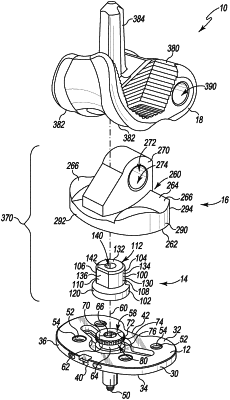| CPC A61F 2/4684 (2013.01) [A61F 2/3859 (2013.01); A61F 2/384 (2013.01); A61F 2/389 (2013.01); A61F 2002/3052 (2013.01); A61F 2002/30331 (2013.01); A61F 2002/30367 (2013.01); A61F 2002/30505 (2013.01); A61F 2002/30576 (2013.01)] | 17 Claims |

|
1. A method of trialing an orthopaedic prosthetic assembly, the method comprising:
assembling a tibial trial component by aligning an insert adaptor with a tibial insert trial and advancing the insert adaptor into an aperture defined in the tibial insert trial to form the tibial trial component, wherein advancing the insert adaptor into the aperture of the tibial insert trial includes receiving a pin located in the aperture defined in the tibial insert trial into an aperture of the insert adaptor;
aligning a tibial trial component with a tibial base trial positioned on a proximal end of a tibia of a patient's joint,
advancing the tibial trial component posteriorly to move a post of the tibial base trial component into a posterior passageway defined in the tibial trial component,
coupling the tibial trial component to the tibial base trial component such that the tibial trial component is permitted to rotate relative to the tibial base trial,
aligning a pair of transverse bores defined in a femoral component with a bore defined in a spine of the tibial trial component,
advancing an elongated pin through the transverse bores and the spine of the tibial trial component to couple the femoral component to the tibial trial component, and
moving the patient's joint through a range of motion including extension and flexion to evaluate a configuration of the orthopaedic prosthetic assembly corresponding to the tibial base trial and the tibial trial component.
|